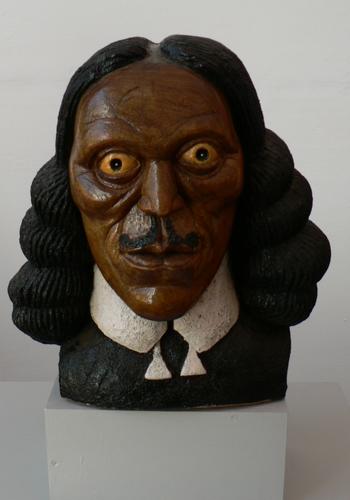The Spier estate in Stellenbosch – on the Helderberg even, if you believe the pricey sixth edition of the World Atlas of Wine by Hugh Johnson and Jancis Robinson – is the closest SA comes to Disney Does Wine. If it doesn’t rain (the roof leaks), you can also visit a terrific contemporary art exhibition which has some uncanny parallels to wine shows.

The 2137 entrants to Spier Contemporary 2007 is larger even than entries to Veritas, the largest SA wine show, which had 1904 in 2007. But unlike Veritas, entrance for participants, is free. And with R1 million in prizes, SC2007 is streets ahead of wine competitions that hand out bronze, silver, gold and double gold medals along with blue diamond and tungsten-tempered kryptonite trophies by the lorry load, but precious little cash. Each one of the seven winners at SC2007 get to trouser R100 000 with the 92 finalists getting R3000 each for their trouble.
For calibration, the Country Cellars Orange River Winemaker of the Year Award, the richest SA wine competition, is worth around R55 000 to the winner in cash and prizes while the Diners Club Winemaker of the Year gets a poverty class trip to a winemaking region of their choice – Chile seems to be the most popular as it’s the priciest ticket. The Diners Club Young Winemaker of the Year gets R5000 and a framed certificate.
Entrance for the public to SC2007 is free, as is parking. Which is certainly not the case with wine competitions with punters paying around R100 a time to taste the bottles of wine winners are expected to donate to the organizers: 4×12 in the case of Diners Club Young Winemaker, which means if the selling price of a winning wine is more than R104/bottle, the winner loses money.
When it comes to judging, cultural cringe rules. Last year the Michelangelo International Wine Awards imported judges from such famous wine producing countries as Colombia, Singapore and Israel while the Classic Wine Trophy continued a proud tradition of not including any SA judges, relying rather on restaurant owners from Kuala Lumpur, a sommelier from Dubai and a wine importer from Taiwan.
The SC2007 judges are equally bizarre, including a Senegalese cultural engineer and Yugoslav art historian in their ranks. And there I was thinking that Yugoslavia no longer exists. The results are likewise as controversial as any wine show: of the six prizes chosen by the judges, no fewer than four came from the Western Cape, which raised a few upcountry eyebrows.
The seventh SC2007 prize will be voted on by visitors to the Cape exhibition, leaving Johannesburg and Durban (to which the exhibition moves later in the year) without a voice. But then, with half the prizes going to performance art which the overwhelming majority of visitors miss, the whole public poll component clearly needs to be rethought.
Still giving the public a vote is a great innovation – rather like the punters at WineX regularly voting for Emil den Dulk’s marvelous De Toren Fusion V Bordeaux blend that is conspicuous by its absence from the list of show performers.
Spier Contemporary 2007 is in a loose sense a successor to the Brett Kebble Art Awards that burst onto the cultural radar screen and then disappeared as suddenly and mysteriously as their patron. Clive van den Berg curated both and they are certainly the most talked about events on the SA contemporary art scene. With William Kentridge Magic Flute labels appearing on wine bottles, the Bell-Roberts Gallery opening a branch on Lourensford and Donald Hess bringing Andy Goldsworthy to Paarl later this month, the story of art and wine has long legs indeed.



